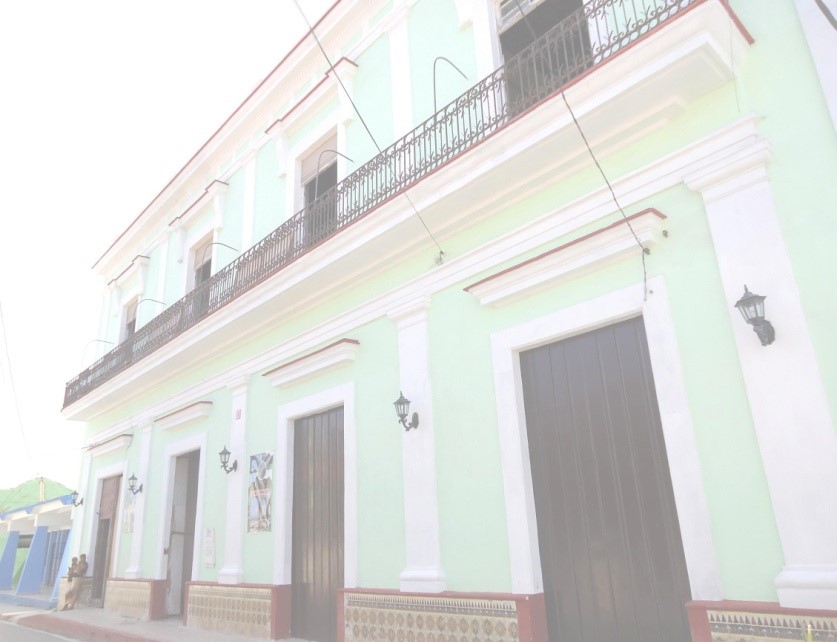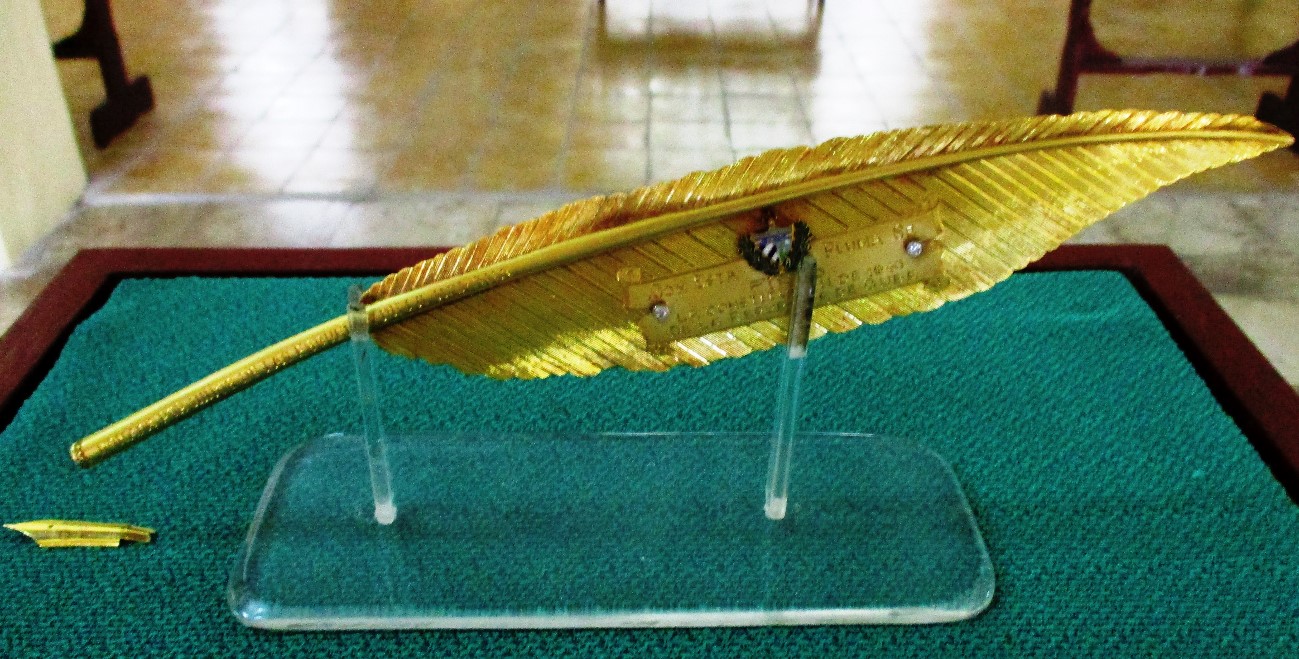Municipal Directorate of Culture

Address: Calle Independencia # 49 A entre J Agüero Calixto García
Director: Yaquelin Yoandra Tapia Aguilera. 52123793
Email: This email address is being protected from spambots. You need JavaScript enabled to view it.
Attention to the population: Ana Lisbet Cuesta Silva
Phones:24844620 24844160

Museum of Art.
Visits to the Museum: Monday to Friday from 8.00am to 4.00pm. Saturday from 8.00am to 11.45am.
Graphic Design and Text Writing: María Chacón Pavón.
Address: Museo de Arte. Independencia No. 19. Gibara.
The neoclassical building where the Museum of Art is located was built approximately in 1866 by order of Atanasio Calderón de la Barca y Villa, a wealthy Spanish merchant based in the town,
Later, from 1910 to 1962 and most of the pieces belonged to the Beola Valenzuela family. José Homobono Beola y Valenzuela, was one of the most powerful merchants and landowners of Gibara.
Its basic model of housing responds to the canons of domestic construction of the 19th century. The first level was used as a warehouse for different consumer products that entered and left through the port of Gibara and the second level was composed of two twin houses.
In 1962 the building became state property and the repair of the house facing Independence Street began, at the same time the inventory and selection of the collections recovered in that house and in other civil constructions of the locality that would form the funds of the museum inaugurated on July 25, 1972. Fifteen years later the institution occupies the entire upper floor of the building, but the adjoining house has not been restored.
Since 1972 more than 2200 unique pieces in the province of Holguin are conserved and protected unique in the province of Holguin.
Room. Medallion style furniture and the decorative arts, 1880-1920.
From the second half of the nineteenth century, the medallion style furniture was one of the most used in the country. Two sets are exhibited in the room, one with simple lines, the other more elaborate, mainly in its decoration based on carvings with naturalistic motifs. Also different manifestations of the decorative arts: a pair of German biscuit porcelain, a decorative glass and bronze vase from the time of the Austro-Hungarian Empire and in the cupboard a variety of glass, silver and porcelain tableware imported from France, Germany and England.
Main hall.
The perillita style furniture was the most used furniture in Gibara in the XIX and XX centuries. That is why it is the most abundant in the museum with its different variants and types. The size of the houses of the bourgeoisie were appropriate to have a great quantity of furniture and utilitarian and purely decorative objects imported from Austria, Germany and France: cane holders, decorative vases, flowerpots, figures, appliqués, among other pieces. The lovers' armchair, which also reflects the character and historical personality of that period, and the Pleyel piano stand out in this ensemble.
Bedroom room for a young lady. In this room set the ornamentation of the perillita style is more elaborate, based on architectural, geometric and floral motifs and elements in the tops of the closet, bed, chest of drawers, washbasin unit, etc. Other features are the refined elaboration of cedar and majagua veneers and the use of gray veined marble. The ambience of the room is completed by various utilitarian and decorative objects.

Saleta proposes this enclosure to expose showcase and knob style living room set accompanied by small seats to rest the feet, whimsical shaped pedestals, flower pots, decorative plates and decorative glass Art Nouveau style in addition to English and French chinaware in the showcase and cupboard respectively.
Ladies' living room. Located next to the lady's bedroom, Cuban furniture influenced by the Art Nouveau style and objects of feminine use predominate. On the sewing table are thimbles, pincushion that has one of the smallest engravings in Cuba, rugs and handkerchiefs. Fans, combs and porcelain and earthenware tableware of emblematic manufactures exhibited in a luxurious showcase made with the technique of gilding.
Originally this room was the interior patio of the house and the modifications were made in 1929 by order of José H. Beola y Valenzuela. The dimensions of this room, the polychrome half points, the columns, the floor of mosaic of capricious elements of different clear tones favor to expose furniture of style perillita and pedestals of wood, marble, bronze sculptures, Art Nouveau style table lamps and pictorial works with urban landscapes and marine of the locality.
Of this group of pieces the painting entitled by the population "La copa del amor" (The Cup of Love) stands out. Original plan of a funerary monument of the locality, elaborated fundamentally with hair where the love, the fiction, the reality and beliefs of the collective memory gibareña merge.
Dining room.
In the design of this room of the museum the combination of its ornamentation stands out, between the colors of the green and pink tile baseboard, tiled floor, walls, false ceiling, furniture and decorative utilitarian objects. Among them is the large, three-section, glass-door sideboard on the back wall, composed of three sections with two Limoges porcelain dishes from the end of the 19th century, delicately decorated with floral motifs and gold fillets. Also on the sideboard are several sets of 19th century French crystal, mainly glasses: for water, beer, champagne, cognac, liqueur, vermouth, wine, among others, worked with carvings, in some cases with whimsical lines and in others with geometric or naturalistic elements.
Perseverance in caring for, protecting, involving and training both technicians and custodians are fundamental premises at the Museum of Art to safeguard its historical and cultural heritage.
The Museum of Art in the community. Project "Encounter with Art" once a month, aimed at workplaces on important dates for this sector of the population. On this occasion dedicated to the "International Day of the language" in special morning in the Municipal Direction of Education: phrases, sayings, tips for the family related to our language that identifies us, as well as sample of Act of the Court of Bayonne, its values and piece of crockery decorated with landscapes allusive to Shakespeare and much more ....".
Typical kitchen of the period: The kitchen is one of the most interesting places of reference of the identity of an era. Located at the back of the house with easy communication with the dining room. Its plateau is L-shaped, with five burners, veneered with tiles imported from Holland. A small cupboard to keep the coal, located in the left side favored the daily tasks, Of the set of exposed objects, Cuban and imported of the end of the nineteenth century and beginnings of the XX century: iron plate, coal tongs, different types of containers, one with the monogram of the Beola family, the tinajero, stands out the refrigerator, furniture of 1900 of exquisite decoration of carvings and lathing.
Municipal Museum of Gibara.
Address: 19 Independencia Street between J Peralta and Luz y Caballero.
Telephone: 24844457
Founded: June 27, 1982.
Opening hours: Tuesday to Friday from 9.00 am to 12.00 pm and from 1.00 pm to 4.00 pm. Saturdays from 9.00 am to 12.00 pm.
Characterization
The Municipal Museum is located in the Historical Center of Gibara, occupies the first floor of a building built in 1866 by Don Atanacio Calderon for his residence and warehouses. Through the years it had different owners and uses. In the 1980s, in order for the municipality to have basic cultural institutions, the municipal government decided to create the Municipal Museum in this building.
The institution, since its foundation, treasures valuable objects and documents, most of which have come through donations.
Its mission is the preservation of the historical and cultural heritage of the territory, offering alternative information about it, while serving as an instrument for the spiritual enjoyment, knowledge and dissemination of our identity.
The tour that is offered to the visitor through its 7 rooms dedicated to the permanent exhibition and 1 room of transitory exhibition, is pleasant and instructive, following a logical sequence that goes from the aborigines to the present time. Others are special, such as the one dedicated to the development of the tobacco industry in the territory,
There is an archive room, which has the particularity of providing service to researchers, where the Notarial Protocols of the nineteenth and early twentieth centuries are grouped.
Among the most relevant exhibits in the institution are a bank bill, minted during the Republic in arms and signed by Carlos Manuel de Céspedes, the flag carried by the Mambi troops upon their entry into Gibara on July 25, 1898, objects and documents related to the expedition disembarked in Gibara on August 17, 1931 under the command of Emilio Laurent, as part of the Cuban people's struggle against the tyranny of Gerardo Machado, the pen used to sign the 1940 Constitution of the Republic of Cuba and the original sketches and sewing machine where the first armbands of the 26th of July Movement were made, which were taken by Frank País to Mexico to be approved by Fidel, and were used for the first time in the November 30 uprising in Santiago de Cuba. These exhibits, along with others stored in the center, are important witnesses of local history and its link to national history.
With a more contemporary museographic design and the constructive characteristics of its building, the institution treasures an invaluable patrimonial wealth in which the peculiarities of the local identity are expressed.


